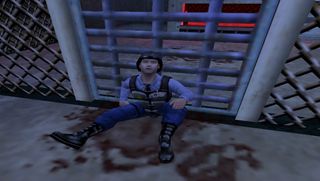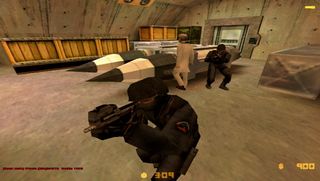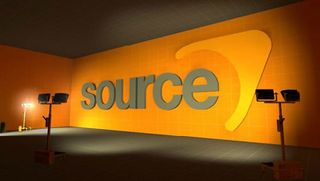Always on

Gamers dislike many things and many people, but if theres one company that they have (almost) universally come to revere, its Valve. Its pretty easy to see why. Its the company behind Steam, the most popular PC gaming platform in the world and the bearer of irresistible game sales. Its the company behind Half-Life, Portal, Counter-Strike, Left 4 Dead.. And its the company run by Gabe Newell, who is, somehow, the most mocked and the most beloved figure in the gaming industry.
So Valve is undoubtedly one of the most important and influential gaming companies around, but its taken 17 long years to reach the point its at today. Believe it or not, there was a time when people werent so willing to create websites like this. To find out why--because, really, that sites great--we went back to the history books, and took a look at Valves roots. Heres what we found.
Two Microsoft millionaires venture out on their own

It may seem weird given their somewhat antagonistic nature today, but Valve as we know it today would not exist without Microsoft. There, a Harvard University dropout named Gabe Newell spent thirteen years helping to produce early versions of the Windows operating system. Naturally, he learned a good deal about the software business working under Bill Gates and crew, and financially, he amassed more than a million dollars as a result of Microsofts desktop dominance.
But by the summer 1996, Newell was looking for a change. So by that August, he and his fellow co-worker/millionaire Mike Harrington took their fortunes and used them to start their own gaming company. They called it Valve, LLC, and they moved their operations to Kirkland, Washington--about five miles west from Microsofts headquarters in Redmond. Once they were situated, they got started on their first game: Half-Life.
Half-Life makes for a grand introduction

Three years before Newell and Harrington left Microsoft to make games, another Microsoft (and later Valve) employee named Michael Abrash did the same. He joined up with Doom developer id Software, and later, helped his former co-workers get a license to use ids Quake engine. With that toolset in tow, Newell, Harrison and their team dug in to create a sci-fi-themed first person shooter of their own.
Valve had big ideas for Half-Life, and it initially had some troubles finding a publisher for the game because of it. Washington-based Sierra On-Line were the one who ended up taking a chance on the young company and its new IP--and when Half-Life launched in November 1998, the move paid off in spades. Half-Life succeeded by almost every metric imaginable, breaking new ground for shooters with the way it seamlessly melded its smart narrative with its smarter gameplay. Millions of copies were sold; Gordon Freeman and his trusty crowbar became iconic; and Valve was firmly on the map.
Half-Life has a life and a half...

For about the next six years, Valve laid dormant when it came to developing and launching completely new titles. There were multiple reasons for that, but one of the biggest was merely that the company wanted to get as much life out of Half-Life as it could. For one, it had future Borderlands makers Gearbox Software develop two expansion packs for the game--1999s Half Life: Opposing Force and 2001s Half-Life: Blue Shift.
Sign up to the 12DOVE Newsletter
Weekly digests, tales from the communities you love, and more
In 1998, it acquired TF Software PTY, which was the team behind the popular Team Fortress mod designed for Quake. A year later, it released Team Fortress Classic, which was effectively that same mod redone in Half-Lifes skin. Valves ulterior motive in buying TF was to develop a sequel to Team Fortress, so it got to work on that too--but like many Valve releases, that game wouldnt come to fruition right away.
...and it has an eternitys worth of mods

But more significantly, the late '90s and early 2000s saw Valve encourage an enthusiastic modding community around Half-Life by releasing the games software development kit (SDK) for free. A veritable truckload of user-created mods soon spawned, and Valve helped foster more than a few of them into becoming more polished releases. Moves like this greatly helped bolster Valves reputation amongst hardcore gamers, earning it a vocal and loyal fanbase thats still crucial to its success today.
Many, many Half-Life mods--and fuller games that started as Half-Life mods--were churned out during this period, including Deathmatch Classic, Ricochet, Gunman Chronicles and Day of Defeat. The most successful of the bunch, though, was a multiplayer mod dubbed Counter-Strike. Developed by Minh Le and Jess Cliffe, the tactical shooter was first released in beta form in 1999, and gained a sizable audience right away. Valve took note, hired the two devs, and released Counter-Strike 1.0 in an official capacity a year later. The game promptly exploded in popularity, becoming the most popular multiplayer FPS not named Halo or Call of Duty for the next decade. It would be updated numerous times in the following years.
Valve gets incorporated and moves (slightly) away

As it continued to support Half-Life and its hungry community, Valve made a few notable moves as a business. In 2000, Harrington departed from the company he co-founded, which left Newell as the lone head honcho. In 2003, it dropped the LLC from its title and became Valve Corporation.
Around that same time, it moved its headquarters about five miles south to Bellevue, Washington. And while all this was happening, Valve started work on two new endeavors that would take it beyond mere game development: Source and Steam.
Steam makes Valve more than a game developer...

Steam was first unveiled at GDC 2002. When it launched a year later, it was far from the all-encompassing behemoth that we know it as today. In fact, it was first posited as a simple digital distribution surface whose main purpose was to deliver patches and other updates to online games more easily. Before, said patches had a nasty habit of crashing games like Counter-Strike and rendering them unplayable for days at a time. When it was out and about, though, people quickly realized Valves angle--and they werent entirely pleased.
Though most of us dont mind now, more than a few Valve loyalists werent happy with Steams online authentication, game launching, and DRM requirements to start. And they were doubly unhappy when Valve announced in 2004 that all of its future games would require Steam to be played. You see, Steam was a bit of a buggy mess at the time, frequently buckling under duress and causing games to crash along with it. Its offline mode was cumbersome for those who didnt want to be forced online all the time, and while it could host multiplayer games and deploy anti-cheating software, it wasnt nearly as featured as it is now. Valves own games and mods were the only ones available for the platform at first, and to top it all off, its UI was ugly. So it had a rocky start.
...and it eventually overcomes its early struggles

But like all things that arent food, Steam got better with age. The technical kinks that marred the platform in its early days got smoothened out, and it soon became speedy and reliable. In 2005, Valve made its first set of distribution agreements with third-party publishers, allowing it to diversify Steams game catalogue beyond its own titles. The platform soon became profitable, and those profits only increased as more and more publishers and PC gamers turned towards digital distribution. From 2007 to 2009, it continued to roll out a range of new features--soon you could store game saves and profile data to the Steam Cloud, fill out achievement lists, or chat with your Steam friends in Steam Community networking groups.
In 2010, the clients UI got a sorely needed and much-improved visual makeover. Mac and Linux clients was later released. And now, you can shop for user-generated content in the Steam Workshop, buy non-gaming apps, check your profile from the Steam smartphone app, vouch for intriguing new titles on Steam Greenlight, and more. The service suffered a nasty hack in November 2011, but, all things considered, its generally been secure. The Steam Store is now the premier PC marketplace for triple-A and indie games alike; and of course, it gives you those delicious Steam sales every now and again. All of this is to say that Steams success snowballed into something thats now Valves greatest asset. It serves tens of millions of users today and takes up an enormous amount of the PC market--and its only getting more robust as time goes on.
Valve unveils a more modular game engine...

The second of Valves big post-Half-Life endeavors was a major update to its GoldSrc game engine. For nearly five years, the company worked on a toolset that would not only be more powerful than before, but would also lend itself to continuous, organic updates. This, in part, explains why Gearbox and others handled Half-Lifes post-release content. When Valve showcased the first footage of Half-Life 2 at E3 2003, the fruits of its labor were revealed.
The engine was named Source, and it officially arrived in August 2004 with the launch of the appropriately-named remake Counter-Strike: Source. Although the revamped physics of that game threw off CS diehards at first, Valve would continue to showcase Sources capabilities in remakes like Half-Life: Source and, later on, Day of Defeat: Source. When Half-Life 2 was finally released later in 2004 (more on that in a few), Sources graphical and physics power were on full display, impressing the masses in the process.
...and it powers a new generation of content

Source brought the usual (but nonetheless impressive) upgrades--better lighting, more realistic physics, smoother graphics, etc.--but its big draw was its heavy modularity. To this day, it doesnt get updated with the usual point releases; instead, it gets more featured through a series of constant, downloadable releases. Its still rooted in the GoldSrc engine--which in turn is rooted in the old Quake engine--so it isnt as powerful as the Unreal Engine 4s of the world, its toolset is a little dated, and its never been very widely used by third-party studios.
But you could argue that was never the point anyways. Source has powered every Valve game since 2004, and those constant updates have helped it hang in there from a technical standpoint today. And since Source is free to the public, its been used by the thousands of modders whove made games out of Valves releases over the past decade. Some of those mods, like Dear Esther or The Stanley Parable, have gone on to achieve notable success on their own. Source is no Unity, but its always been something of an engine for the people, and thats worth something.













Intergalactic: The Heretic Prophet is "a game about faith and religion," which Neil Druckmann jokes will surely get less hate than The Last of Us 2

The Last of Us creator Neil Druckmann says Intergalactic: The Heretic Prophet will also be about "being lonely," as if his zombie apocalypse wasn’t isolating enough: "I really want you to be lost"




